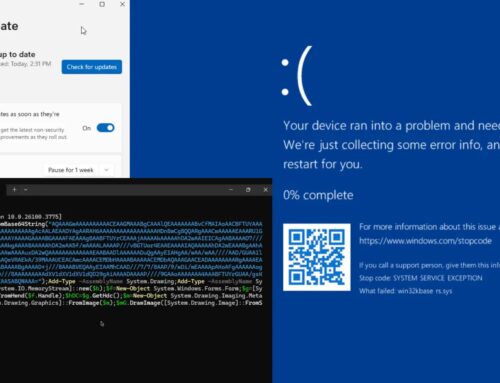
Threat Actors Weaponizes LNK Files to Deploy RedLoader Malware on Windows Systems
The cybersecurity landscape is in a constant state of flux, with threat actors continuously refining their strategies to breach defenses. A recent and particularly concerning development involves the GOLD BLADE cybercriminal group, which has significantly enhanced its attack methodology. This group is now weaponizing LNK files in conjunction with a recycled WebDAV technique to deploy their custom RedLoader malware on Windows systems, posing a substantial risk to organizations globally.
This sophisticated infection chain, observed surging in July 2025, underscores the critical need for robust defense mechanisms and a proactive security posture. As cybersecurity analysts, understanding these evolving tactics is paramount to safeguarding digital assets.
Evolving Tactics: LNK Files and WebDAV in Malware Deployment
The innovation by GOLD BLADE lies in its fusion of known techniques to create a more potent threat. The core of this new campaign revolves around malicious LNK files. These shortcut files, often overlooked, are inherently capable of executing commands or scripts when opened. In this context, they serve as the initial vector for the attack.
Complementing the LNK file execution is the recycling of a WebDAV technique. Web Distributed Authoring and Versioning (WebDAV) is an extension of HTTP that allows clients to perform remote web content authoring operations. While legitimate for collaboration, threat actors exploit its capabilities to host and deliver malicious payloads. By leveraging WebDAV, GOLD BLADE can discreetly serve the RedLoader malware, often bypassing traditional perimeter defenses that might scrutinize direct executable downloads.
The combination of these two elements creates a highly effective pathway for initial compromise, allowing the RedLoader malware to gain a foothold on target systems.
Introducing RedLoader Malware: A Custom and Potent Threat
RedLoader is the custom malware central to GOLD BLADE’s operations. While the specific functionalities of RedLoader are not exhaustively detailed, its prominence in a sophisticated infection chain indicates a highly capable and versatile payload. Custom malware often possesses several advantages for threat actors:
- Evasion Capabilities: Tailored code can be optimized to bypass antivirus and endpoint detection and response (EDR) solutions, making it harder to detect.
- Specific Functionality: Custom malware can be designed for specific objectives, such as data exfiltration, remote access, or the deployment of additional payloads.
- Reduced Signature Detection: Unlike publicly available malware, custom variants have fewer, if any, existing signatures, prolonging their operational lifespan.
The deployment of RedLoader via this refined attack vector highlights GOLD BLADE’s commitment to developing and utilizing potent tools for their illicit activities.
The Threat Actor: GOLD BLADE Cybercriminal Group
The GOLD BLADE cybercriminal group is the perpetrator behind this evolving threat. While the full scope of their previous activities is not detailed in the provided information, the description of their techniques as “previously observed” and now “significantly evolved” suggests a group with a history of sophisticated operations. Understanding the tactics, techniques, and procedures (TTPs) of specific threat actors like GOLD BLADE is crucial for developing targeted defenses and threat intelligence. Their continuous adaptation signifies a persistent and dangerous adversary.
Remediation Actions and Proactive Defense
Defending against advanced threats like those employed by GOLD BLADE requires a multi-layered approach. Organizations must prioritize both preventative measures and robust detection capabilities. Here are key remediation actions and proactive defense strategies:
- User Education and Awareness: Train employees to recognize and report suspicious LNK files, phishing attempts, and unusual email attachments. Emphasize caution with files from unknown senders.
- Disable LNK File Execution (Where Possible): Consider policies that limit the automatic execution of LNK files, particularly from network shares or external sources. While challenging to universally implement, this can reduce the attack surface.
- Implement Strong Endpoint Detection and Response (EDR) Solutions: EDR tools can monitor for suspicious process execution, network connections (especially to WebDAV servers), and file modifications that might indicate RedLoader’s presence.
- Network Segmentation: Limit lateral movement in case of a breach by segmenting crucial network resources. This can contain the spread of malware like RedLoader.
- Regular Security Audits and Penetration Testing: Proactively identify vulnerabilities in your network and systems that threat actors might exploit.
- Patch Management: Ensure all operating systems, applications, and network devices are regularly updated with the latest security patches. While not directly detailed as an exploit in this specific campaign, unpatched vulnerabilities remain a common entry point.
- Web Proxy and Content Filtering: Implement robust web proxies and content filtering to block access to known malicious WebDAV servers and suspicious websites.
- Disabling WebDAV Client (If Not Required): If your organization does not actively use the WebDAV client, consider disabling it or restricting its functionality to reduce the attack surface.
- Threat Intelligence Sharing: Stay informed about the latest TTPs of groups like GOLD BLADE by subscribing to reputable threat intelligence feeds.
Relevant Tools for Detection and Mitigation
Leveraging the right tools is essential for detecting and mitigating threats posed by sophisticated malware like RedLoader. Here’s a table of useful categories and examples:
| Tool Category | Purpose | Example Tools |
|---|---|---|
| Endpoint Detection & Response (EDR) | Real-time monitoring, detection, and response to threats on endpoints. Critical for identifying malware behaviors and anomalous activity. | CrowdStrike Falcon, Microsoft Defender for Endpoint, SentinelOne |
| Network Traffic Analysis (NTA) | Monitoring and analyzing network traffic for suspicious patterns, connections to malicious IPs, and unusual WebDAV activity. | Zeek (formerly Bro), Wireshark, Corelight |
| Security Information & Event Management (SIEM) | Centralized collection and analysis of security logs from across the IT infrastructure to correlate events and detect indicators of compromise (IoCs). | Splunk ES, IBM QRadar, Microsoft Azure Sentinel |
| Vulnerability Management | Scanning and identifying vulnerabilities in systems and applications that could be exploited by threat actors. | Nessus, Qualys, OpenVAS |
Conclusion
The evolution of the GOLD BLADE cybercriminal group’s tactics, particularly their use of weaponized LNK files and recycled WebDAV techniques to deploy RedLoader malware, serves as a stark reminder of the dynamic nature of cyber threats. For IT professionals, security analysts, and developers, remaining vigilant and proactive is not merely recommended but essential. By implementing comprehensive security measures, investing in relevant tools, and fostering a culture of cybersecurity awareness, organizations can significantly enhance their resilience against such sophisticated attacks.





